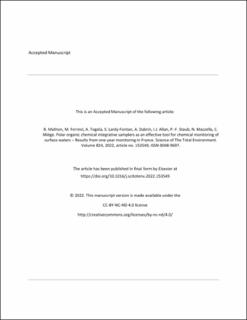| dc.contributor.author | Mathon, B. | |
| dc.contributor.author | Ferreol, M. | |
| dc.contributor.author | Togola, A. | |
| dc.contributor.author | Lardy-Fontan, S. | |
| dc.contributor.author | Dabrin, A. | |
| dc.contributor.author | Allan, Ian | |
| dc.contributor.author | Staub, P.-F. | |
| dc.contributor.author | Mazzella, N. | |
| dc.contributor.author | Miège, C. | |
| dc.date.accessioned | 2023-04-27T08:09:53Z | |
| dc.date.available | 2023-04-27T08:09:53Z | |
| dc.date.created | 2022-05-23T08:58:12Z | |
| dc.date.issued | 2022 | |
| dc.identifier.citation | Science of the Total Environment. 2022, 824, 153549. | en_US |
| dc.identifier.issn | 0048-9697 | |
| dc.identifier.uri | https://hdl.handle.net/11250/3065227 | |
| dc.description | Embargoed until 18.02.2024 | |
| dc.description.abstract | In an effort to support European Union Water Framework Directive goals, we have set up a national demonstrator project to identify the advantages and limitations of passive samplers for regulatory monitoring of polar contaminants in surface waters. Here we carried out successive 14 day-deployments of polar organic chemical integrative samplers (POCIS) for one year at three sites. In parallel, we used the passive sampler deployment/retrieval operations to collect spot water samples for comparative analysis. We observed that frequency of quantification was significantly higher in POCIS than spot samples for 29 contaminants, similar for 15, and lower for one, because POCIS lowered the limits of quantification for most contaminants (median value factor of 11). We built a database of sampling rates (Rs) according to quality indices to convert concentrations in POCIS to concentrations in water (23 contaminants with a high-quality median Rs value, 20 with an approximate Rs and two with no usable Rs). Several phenomena were observed over one-year monitoring period. For example, after a flood episode, dilution phenomenon in rivers is correctly observed by using POCIS sampling whereas significant concentration increased due to soil leaching is observed with both passive and spot sampling. Cases of episodic contamination that were missed by spot sampling were observed with POCIS as it was able to capture contamination of short duration but sufficient intensity. Contamination by pharmaceuticals was found to come from wastewater treatment plant discharges and showed relatively little variation over the course of the year in both POCIS and spot samples. POCIS enables more reliable annual monitoring of pesticide and pharmaceutical contamination than spot sampling. Furthermore, POCIS also improves the environmental quality standards based assessment of chemical status and on annual average concentrations compared to spot sampling. This study demonstrates the value and practicability of POCIS-based chemical monitoring for use in regulatory control networks. | en_US |
| dc.language.iso | eng | en_US |
| dc.publisher | Elsevier | en_US |
| dc.rights | Attribution-NonCommercial-NoDerivatives 4.0 Internasjonal | * |
| dc.rights.uri | http://creativecommons.org/licenses/by-nc-nd/4.0/deed.no | * |
| dc.title | Polar organic chemical integrative samplers as an effective tool for chemical monitoring of surface waters – Results from one-year monitoring in France | en_US |
| dc.type | Peer reviewed | en_US |
| dc.type | Journal article | en_US |
| dc.description.version | acceptedVersion | en_US |
| dc.source.pagenumber | 13 | en_US |
| dc.source.volume | 824 | en_US |
| dc.source.journal | Science of the Total Environment | en_US |
| dc.identifier.doi | 10.1016/j.scitotenv.2022.153549 | |
| dc.identifier.cristin | 2026306 | |
| dc.source.articlenumber | 153549 | en_US |
| cristin.ispublished | true | |
| cristin.fulltext | postprint | |
| cristin.qualitycode | 2 | |

